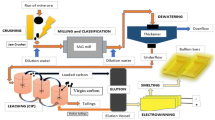Abstract
With the development of the electrolytic aluminum industry, a large number of waste cathode carbons (WCC) of electrolytic aluminum remain, which are typical harmful solid wastes and cause serious harm to the environment. The harmless treatment of WCC is extremely important. Conventional heating and steaming is a good treatment method for WCC blocks. Fluoride has good selective heating characteristics, which promote the transformation of fluoride to escape in the form of gas, and realizes the separation of carbon and fluorine in the WCC of electrolytic aluminum. The characterization of WCC under steam high-temperature calcination was compared with that under traditional high-temperature calcination and chemical leaching. Tests show that, under the condition of water vapor, the carbon layer of WCC is larger, which is more conducive to the separation of carbon and fluorine. In this paper, the effects of different temperatures, heating times, and water flow rates on the defluorination rate were studied. The results showed that, when the WCC was heated at 950°C for 3 h, and the flow rate was 3.5 g/min, the defluorination effect of cathode carbon was the best, reaching 93%.








Similar content being viewed by others
References
P.B. Personnet, Essential Readings in Light Metals (Springer, Berlin, 2016), pp 1049–1056.
D.F. Lisbona, C. Somerfield, and K.M. Steel, Hydrometallurgy 134, 132 (2013).
V. Mambakkam, R. Alicandri, and K. Chattopadhyay, Light Metals 2019 (Springer, Berlin, 2019), pp 857–866.
M.L.G. Renó, F.M. Torres, R.J. da Silva, J.J.C.S. Santos, and M.D.L.N.M. Melo, Energy Convers. Manag. 75, 98 (2013).
D.F. Lisbona, and K.M. Steel, Sep. Purif. Technol. 61, 182–192. (2008).
A. Agrawal, K. Sahu, and B. Pandey, Resour. Conserv. Recycl. 42, 99. (2004).
T. Maffei, R. Khatami, S. Pierucci, T. Faravelli, E. Ranzi, and Y.A. Levendis, Combust. Flame 160, 2559 (2013).
R. Hurt, J.-K. Sun, and M. Lunden, Combust. Flame 113, 181. (1998).
S. Bhatia, and D. Perlmutter, AIChE J. 27, 247. (1981).
I. Smith, Combust. Flame 17, 303. (1971).
A. Agrawal, C. Kumar, and A. Meshram, Mater. Today Proc. 46, 1526. (2021).
G. Holywell, and R. Breault, JOM 65, 1441 (2013).
S. Dubey, and D. Holmes, World J. Microbiol. Biotechnol. 11, 257. (1995).
P.Y. Brisson, G. Soucy, M. Fafard, H. Darmstadt and G. Servant, In TMS 2005, (2005).
N. Bell, J.N. Andersen and H.-K.H. Lam, (Google Patents: 1978).
R.P. Pawlek, Light Metals 2012 (Springer, Berlin, 2012), pp 1313–1317.
S.M.J. Mirazimi, F. Rashchi, and M. Saba, Sep. Purif. Technol. 116, 175 (2013).
L. Andrade-Vieira, L. Davide, L. Gedraite, J. Campos, and H. Azevedo, Ecotoxicol. Environ. Saf. 74, 2065. (2011).
R.P. Pawlek, JOM 45, 48. (1993).
B. Sanjuan, and G. Michard, Geochim. Cosmochim. Acta 51, 1823. (1987).
N. Li, G. Xie, Z.X. Wang, Y.Q. Hou and R.X. Li, In Advanced Materials Research, (Trans Tech Publ: 2014), pp. 1660–1664.
J. Xiao, J. Yuan, Z. Tian, K. Yang, Z. Yao, B. Yu, and L. Zhang, Ultrason. Sonochem. 40, 21. (2018).
J. Yuan, J. Xiao, F. Li, B. Wang, Z. Yao, B. Yu, and L. Zhang, Ultrason. Sonochem. 41, 608. (2018).
M. Somerville, R. Davidson, S. Wright, and S. Jahanshahi, J. Sustain. Metall. 3, 486. (2017).
J.B. Snodgrass and E.L. Cambridge, (Google Patents: 1984).
G. Felling, and P. Webb, Light Met. Age-Chicago 53, 40. (1995).
Z.-N. Shi, L. Wei, X.-W. Hu, B.-J. Ren, B.-L. Gao, and Z.-W. Wang, Trans. Nonferrous Met. Soc. China 22, 222. (2012).
U. Ntuk, S. Tait, E.T. White, and K.M. Steel, Hydrometallurgy 155, 79. (2015).
B. Silveira, A. Dantas, J. Blasquez, and R. Santos, J. Hazard. Mater. 89, 177. (2002).
J.L. Rose, J. Mu and Y. Cho, in Proceedings of the 17th World Conference on Non-Destructive Testing, Shanghai, China, (Citeseer: 2008), pp. 25–28.
C. Ghenai, A. Inayat, A. Shanableh, E. Al-Sarairah, and I. Janajreh, Sci. Total Environ. 684, 519. (2019).
M. Cenčič, I. Kobal, and J. Golob, Chem. Eng. Technol. Ind. Chem.-Plant Equip.-Process Eng.-Biotechnol. 21, 523. (1998).
Z. Bo, J. Zhao, L. Liang, R. Shi, W. Tang, and X. Li, Light Met. 5, 27. (2015).
Acknowledgements
Yunnan Ten Thousand Talents Plan Industrial Technology Talents Project (2019–1096), Yunnan Ten Thousand Talents Plan Young & Elite Talents Project (2018-73) and the Analysis and testing fund of Kunming University of Science and Technology (2021T20090154).
Author information
Authors and Affiliations
Corresponding author
Ethics declarations
Conflict of interest
The authors declare that they have no known competing financial interests or personal relationships that could have appeared to influence the work reported in this paper.
Additional information
Publisher's Note
Springer Nature remains neutral with regard to jurisdictional claims in published maps and institutional affiliations.
Rights and permissions
About this article
Cite this article
Cai, W., Xia, H., Zhang, Q. et al. Defluorination of Waste Cathodic Carbon Through Steam Under Conventional High-Temperature Roasting. JOM 75, 400–406 (2023). https://doi.org/10.1007/s11837-022-05544-1
Received:
Accepted:
Published:
Issue Date:
DOI: https://doi.org/10.1007/s11837-022-05544-1




